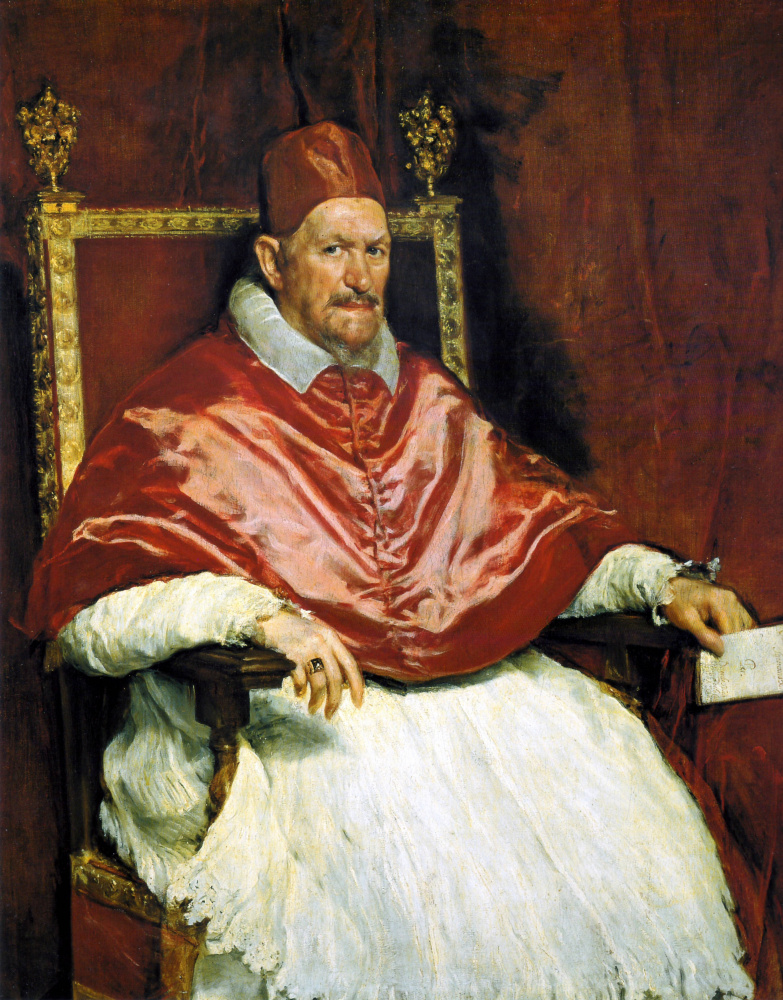log in
Enter site
Login to use Arthive functionality to the maximum
Portrait of Pope Innocent X
Diego Velazquez • Painting, 1650, 140×120 cm
Description of the artwork «Portrait of Pope Innocent X»
"Troppo vero!” Pope Innocent X exclaimed when Diego Velázquez finished his portrait. These words mean “Very alike!” We have collected six interesting facts about the painting, which is considered the unsurpassed pinnacle of 17th century portrait art.
1. How did Diego Velázquez manage to get such a high-ranking client?
That was not easy. Before painting the portrait of the Pope, 50-year-old Velázquez was little known in Italy, although he was the court artist and a close person of the Spanish king Philip IV. Once in Rome, Velázquez took an unconventional move aimed at making the noble and wealthy Italians know about his skills. He painted a superb portrait of his servant Juan de Pareja and sent the model along with his image to Italian villas, demonstrating the virtuosity of the Spanish brush. The result exceeded all expectations: in the same year, Velázquez was invited to an audience with Pope Innocent X, and after a conversation, the artist was commissioned a generation portrait of the pontiff.
2. What were Pope Innocent X and Cardinal Mazarin at odds over?
At the time of painting the portrait, the Pope was about 75 years old. However, he looked much younger: Velázquez perfectly conveyed the blush on his cheeks (however, perhaps these are just crimson reflexes from his scarlet satin cape, which is also painted with extreme skill) and the sober, attentive look. Innocent X occupied the papal throne for more than 10 years, from September 1644 to January 1655, and at this difficult time of Europe he was one of its most influential politicians; it would be naive to think that the Pope’s activities are only limited to internal church issues. For example, he squeezed out of Italy the most influential Barberini clan, accusing them of a large embezzlement of public funds. Brothers Antonio, Francesco and Tadeo Barberini fled to France, where they were sheltered by Cardinal Mazarin (we know him from Dumas’s novels, however real Mazarin was much more influential and less funny than the author of The Three Musketeers portrayed him). Mazarin, although born Italian, was a political opponent of Innocent X. Mazarin was one of the initiators of the Peace of Westphalia, which ended the Thirty Years’ War, whereas Innocent condemned the Peace of Westphalia, as he counted on the victory of the Habsburg bloc (Spain and Austria). In general, it is not surprising that the Habsburg court painter, Diego Velázquez, aroused sympathy in the Pope.
3. The Doria Pamphilj Gallery, where the portrait is kept, was founded by the Pope himself
The portrait of Innocent X has not changed its location from the moment of its creation to the present day. It is on view in the Doria Pamphilj Gallery at Via del Corso, Rome. The collection of the museum is based on the personal collection of Innocent X, born Giovanni Battista Pamphilj.
4. Innocent X holds Velázquez’s autograph in his hand
Velázquez had an original way to put his signature on the paintings — it organically fit into the picture. For example, in this portrait, the pontiff is holding a card on which you can read the inscription “To His Holiness Pope Innocent X from Diego de Silva y Velázquez, the court painter of His Majesty the Catholic King”.
5. The artist Guido Reni also painted Innocent X, but as the devil
Guido Reni created The Archangel Michael Defeating Satan painting for the Church of Santa Maria della Concessione in Rome. The head of the devil, flattened under the heel of the leader of the heavenly host, suspiciously resembles Innocent X. And this is not surprising: the client of the picture was the Barberini clan, which was in a long-term competitive struggle with the Pamphilj clan.
6. 20th century British expressionist Francis Bacon became famous for his “cover versions” of this portrait
The famous brawler and one of the most expensive artists of the twentieth century, Francis Bacon who specialized in distorting bodies and objects, was especially inspired by this portrait by Velázquez. Bacon admitted that he “just went nuts on the Pope” and clarified: “I think it’s all about his magnificent colours”. According to Wikipedia, in 2007, his Study after Velázquez’s Portrait of Pope Innocent X was purchased by Qatari sheikhs for $ 53 million, and the Screaming Pope by Bacon (based on the same work by Velázquez influenced by a frame from Eisenstein’s Battleship Potyomkin silent film) was auctioned for $ 25.6 million in 2012.
Written by Anna Vcherashniaya


